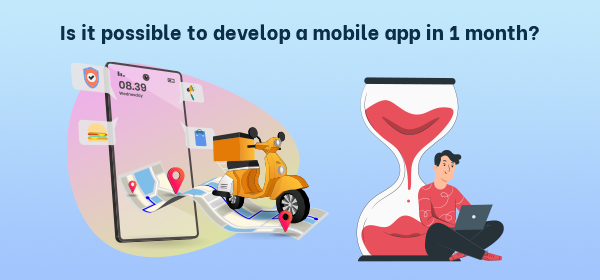While thinking about Magento 2 mobile app development, the first question that comes up is the development time. If you ask the developers about it, you will often get vague answers such as “I don’t know”, “I am not sure”, etc. The primary reason is they are humans.
They won’t know what functionality you expect in a mobile app for the Magento website. Some businesses require multiple payment options, while others focus on branding. Apart from this, there are numerous factors such as the type of mobile app, whether you need a progressive web app vs native. The expertise of the development team also plays a major role in development. Lastly, your, i.e., customers’ active involvement in the process determines the development time.
If you consider all this, you may get an estimation. However, the actual delivery date can’t be sure until it’s released.
Now, if you’re planning to develop a Magento 2 mobile app with us, here’s how we will go through it. This article will guide you about the development process that experienced companies follow even if you’re not.
Requirements from Customers’ Side
You need to be well-prepared before you head to a development team for your Magento 2 mobile app. Identify your requirements, know your target audience, research the market and customer demands, decide your budget, and create a plan. With this plan, you should go to the development team.
All these things will give you clarity about your requirements. It will help you identify what you require, which will make it easy for developers to build the app. Depending on the complexity and other factors, it may take 2-3 months if you have ideas. However, if you don’t have a plan, the duration may exceed 4-5 months or probably more. The reason is that you don’t know what you and your customers need, and the feature you may think satisfactory today may look unsatisfactory in the next sprint.
Hence, before undergoing development, research the audience, ideas for your Magento 2 mobile app, the features you want to add, the type of app you would like to build, and decide your estimated budget.
Also, learn about the Magento 2 mobile app development companies. Shortlist the companies and then reach out to the suitable ones.
Do this if you don’t want to end up with an inexperienced team, as that affects the development time too.
Once you have the clarity and plan to build a mobile app for the Magento website, reach out to the development team. Here starts the correctly estimated delivery time for a custom Magento app by AppJetty.
1. Requirement Gathering
Once you sign up with AppJetty, our team will approach you to discuss your requirements and how we can help.
This meeting will cover everything about your industry, your requirements for mobile apps, such as your mobile app-specific ideas, features to integrate, expected delivery date, budget constraints, technological requirements, and so on. Our team will suggest the solution and features best according to your industry and business based on your plan and requirement. We will also clear all the nuances and complexities in the solution, like features that might be difficult to incorporate considering the nature of your app. We will also explain our development procedure, the financial aspects, and your role in the process, in this meeting.
If you have any specific requirements, we will consider those too in our first meeting. However, note that this won’t be the final call for your requirements. This meeting will help us identify your requirements and the best solution that we can offer.
Estimated Time Duration: Requirement gathering takes one or two meetings.
2. Create a Plan
Once we know about your requirements, we will cross-check it with our base products and see if it fits a readily available solution with a few customizations. In the Magento 2 app development case, we cross-check it with our Magento 2 App builder – a pre-built mobile framework that lets you launch your app within weeks.
Here’s an article to help you choose between app builder and custom development.
If we need to build a custom solution, we will create a list of requirements and a roadmap. This roadmap will cover the list of features we will develop, total sprints, estimated delivery for each sprint, customizations, cost, and invoice.
We will explain this entire roadmap in the S.O.W. document. Once ready from our side, we will share the document with you for review. You can go through it, learn about the features, cost, and duration, etc. If you have any additional requirements, say customization, you can come up with them.
We will create the final S.O.W. based on the inputs from the estimation team, technical team, and client, i.e., you. Once you’ve verified the document, we will create the agreement, after which the development procedure will start.
Estimated Duration: It takes about a week to cross-check the requirements and get the final S.0.W ready.
3. Development and Q.A. Analysis
With a plan in hand, the technical team starts with the development process. Like other standard companies, we follow Agile methodology, i.e., our client always stays in the loop. The client is part of the weekly demos, and if unavailable, we shall update you about the meeting via email.
This ensures that you know about your app’s development, like developed features, the progress, etc. The standup meetings are more like discussions where we consider everyone’s feedback. The weekly demo meetings allow everyone to give their inputs. If you want to change the design or a feature, you can give your inputs. Remember, it’s about discussing the features and requirements in the S.O.W. We shall consider any additional feature or customization requirement as extra.
Also, we don’t believe in the develop-first and test-later approach. As the modules are ready, our QA team starts testing the limitations. So, if any bug or issue arises, we can solve it therein, eliminating the chances of last-minute errors.
Note: It doesn’t mean that we won’t test the app after the development. After the app is developed, our QA team undergoes in-depth testing, checking each and every module so that the launch can be smooth.
Estimated Duration: It takes approx 3-4 months to develop a custom Magento 2 mobile app.
4. UAT
At this stage, the app is fully developed and handed over to the client for final approval. Clients can test the app, see how it works, and develop feedback or changes they require.
Generally, the UAT, i.e., user testing, should take over 1-2 days. However, the accurate time to pass this stage and get ready for the final launch depends on clients. Sometimes, a client may take over a week to approve the app, which may delay the launch as app stores take time for publishing.
5. Release
Once we get the approval, we deliver the app with documentation and provide 3-month free support and maintenance as you start using it.
Total estimated time: It takes 5-6 months to develop a custom mobile app for the Magento website. The number may go up or down depending on the factors we discussed before. If you want to launch an app within weeks, we offer an alternate solution, i.e., App Builder.
Magento 2 Mobile App Builder: Release Process
The process starts with the client’s demo request.
- First, the sales team contacts the client, explains the app builder and gives a demo. Clients can even view the demo on their own by using the username and password on the product page.
- After you place the order, our tech team will start with the installation and application setup. The setup will cover everything, including data migration and data sync. It takes around 2-3 days for a complete setup.
- With the setup starts the testing period. Here, the client receives the app for final approval.
- The client confirmation is followed by the release, i.e., publishing on the app store. It takes around 4-5 days to release as app stores have specific guidelines and publishing procedures.
- Once it’s released, the client can start using it.
If you go by this process, it takes approx 2-3 weeks to launch the app. However, if you need any custom features in the app and want to make it white-label, well, it might take a bit more time. However, it would be half of a custom-developed one, and that’s for sure.
All product and company names are trademarks™, registered® or copyright© trademarks of their respective holders. Use of them does not imply any affiliation with or endorsement by them.





